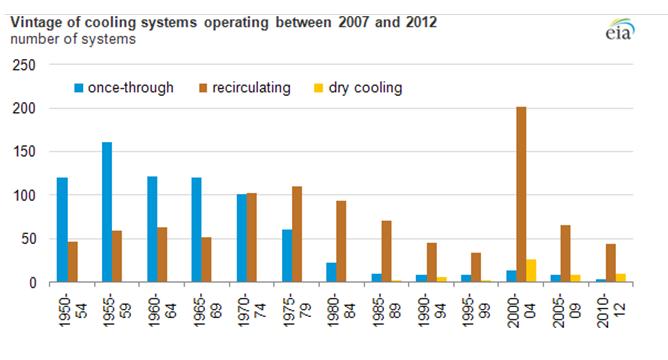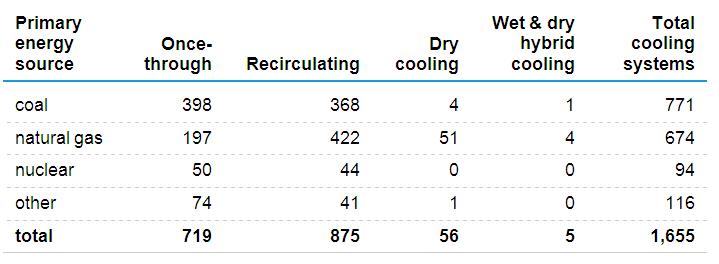U.S. electric generating plants have moved toward cooling systems that reuse water, mainly because of environmental standards that seek to limit excess heat from the water that can damage fish and other wildlife (thermal discharge) and to limit damage to organisms trapped when water is withdrawn from a source (called impingement).
Many types of power plants generate electricity by boiling water to produce steam, which is then passed through a turbine. Such plants include ones that burn coal and biomass, nuclear plants, some natural gas plants, and even some solar facilities. Once the steam has passed through the turbine at these plants, it must be cooled so it can condense back to a liquid and be returned to the boiler or steam generator. Plants that require the use of cooling water account for a little more than 70% of all the electricity in the nation and nearly 60% of the electric generating capacity.

Source: U.S. Energy Information Administration, Form EIA-860, Annual Electric Generator Report. Note: Data on cooling systems are collected from power plants that have a combined net summer capacity of 100 MW or more. The chart above excludes systems built and retired prior to 2007. Individual components of systems reported to EIA by plant owners and operators as being part of a composite cooling system have been treated as separate systems.
2here
Withdrawal is the amount of water a power plant takes in from a source such as a river, lake, or ocean for the purpose of cooling steam. Consumption is the amount of water lost through evaporation while cooling. Concerns about thermal discharge (the temperature of water at discharge back to the river or lake) as well as harm to organisms through impingement (when fish or wildlife are crushed when brought into a cooling system) and entrainment (when the cooling system itself harms wildlife) are all regulated by EPA under the Clean Water Act.
Plants have historically used one of two methods to condense steam for electricity generation. Before 1970, most of the cooling systems built in the United States to condense steam were once-through systems. At a once-through system, cooling water is drawn from a natural body like a lake or river, is passed through a plant a single time, and is then returned to the same (or sometimes different) body of water. The construction of such units peaked between 1955 and 1959.

Source: U.S. Energy Information Administration, Form EIA-860, Annual Electric Generator Report. Notes: Other consists of biomass, wood and wood-waste products, petroleum, and gases other than natural gas. Data on cooling systems are collected from power plants that have a combined net summer capacity of 100 MW or more. The table above excludes systems built and retired prior to 2007. Individual components of systems reported to EIA by plant owners and operators as being part of a composite cooling system have been treated as separate systems.
Power plants built after the 1960s shifted toward cooling systems that reuse water, known as recirculating systems. Construction of these units peaked between 2000 and 2004 when a total of 201 systems were built. At a recirculating system, water is kept in closed-loop piping so it can be used repeatedly. Recirculating systems can consist of a cooling tower or a cooling pond with both using ambient air to draw energy out of the cooling water that was used to condense the steam.
At a cooling tower, the process of lowering the cooling water temperature produces the plumes of evaporation often associated with power plants. Some water is lost through evaporation at a cooling pond as well, but the mode of energy transfer is fundamentally different.
Recently, plants have started using a third type of cooling system known as dry cooling. Instead of using water to lower cooling water temperature, these systems use air passed over the cooling water by one or more large fans. Running those fans can require a significant amount of electricity, which makes this system less suited for large plants that require a lot of steam such as those powered by coal or nuclear energy. They can, however, be used to support the thermal portion of combined-cycle natural gas plants (normally less than 50% of the plant’s total output).
Of the 1,655 operable cooling systems in the United States, 875 (53%) reuse water either through a cooling tower or a cooling pond, while 719 (43%) do not reuse water. The remaining systems are either dry (56 systems) or hybrid (5 systems), which can switch between dry and some sort of wet cooling depending on the temperature and availability of water.
Once-through systems are cheaper to build than recirculating systems, which have a greater infrastructure requirement (e.g., construction of a cooling tower or cooling pond). Once-through systems consume less water than recirculating cooling systems. Although once-through cooling systems withdraw a lot of water, essentially all of it is returned to the water source. Recirculating systems only withdraw enough water needed to maintain the required water level of the system, but they consume water through evaporation.
Once-through and recirculating systems also have different effects on the ecosystems around them. Specifically, once-through systems return water to the water source at a higher temperature than at withdrawal and risk impingement or entrainment of aquatic organisms. The Environmental Protection Agency (EPA) is currently considering regulations designed, in part, to minimize such risk through Section 316(b) of the Clean Water Act. EPA is expected to issue the rule in early 2014.
For more information on individual cooling systems (and on related boilers and generators), see data collected on theForm EIA-860, Annual Electric Generator Report and Form EIA-923, Power Plant Operations Report.
Principal contributor: Vlad Dorjets
Energy Information Agency
www.eia.gov
Filed Under: News, Policy




